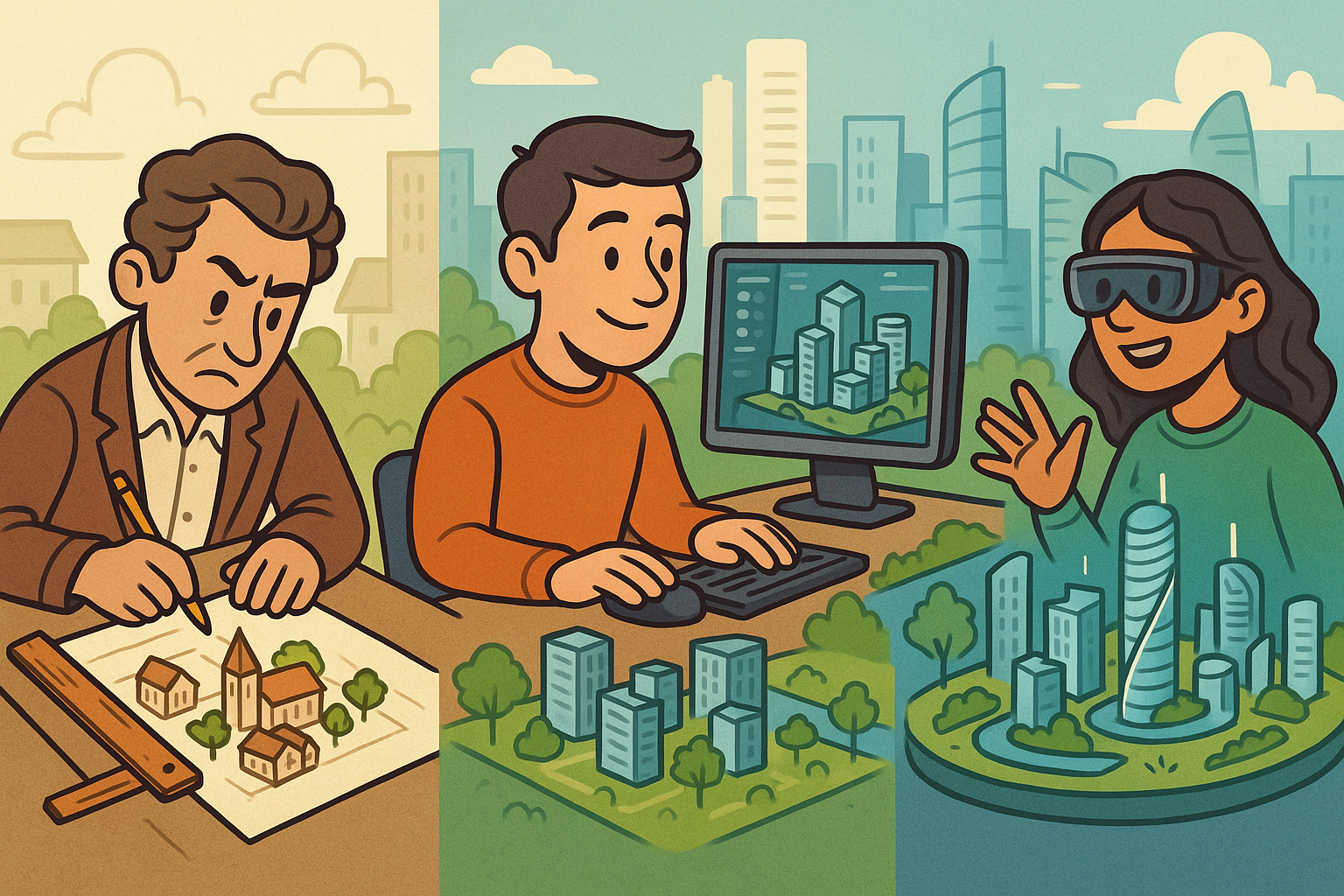Your Cart is Empty
Customer Testimonials
-
"Great customer service. The folks at Novedge were super helpful in navigating a somewhat complicated order including software upgrades and serial numbers in various stages of inactivity. They were friendly and helpful throughout the process.."
Ruben Ruckmark
"Quick & very helpful. We have been using Novedge for years and are very happy with their quick service when we need to make a purchase and excellent support resolving any issues."
Will Woodson
"Scott is the best. He reminds me about subscriptions dates, guides me in the correct direction for updates. He always responds promptly to me. He is literally the reason I continue to work with Novedge and will do so in the future."
Edward Mchugh
"Calvin Lok is “the man”. After my purchase of Sketchup 2021, he called me and provided step-by-step instructions to ease me through difficulties I was having with the setup of my new software."
Mike Borzage
Design Software History: Evolution of Design Software in Shaping Smart Urban Environments: Historical Insights and Future Innovations in Urban Planning
October 05, 2025 14 min read


Introduction and Historical Context: Urban Complexity and Digital Evolution
The urban landscape has always been a microcosm of human advancement, and in recent decades, the emergence of the smart city movement has dramatically reshaped how planners, architects, and engineers conceive modern urban environments. The increasing complexity of megacities, intertwined transportation networks, and the spatial challenges arising from population growth have necessitated innovative approaches to design and infrastructure management. Urban environments are now evaluated through an integrated lens that accommodates sustainability, digital connectivity, and practical logistics, thus requiring the evolution of conventional planning paradigms. In this context, the critical evolution of design software from rudimentary drafting tools to advanced digital solutions is a centerpiece of modern urban strategy. This transition was not sudden but the result of decades of incremental improvements, largely driven by technological advancements and visionary thinking by early innovators, paving the way for integrated, data-driven urban design methodologies.
Digital Evolution and Urban Strategy
Over time, traditional drafting and design methodologies began to be augmented by computer-generated images and data analytics — a shift that was essential for conceptualizing the layered complexities of modern metropolises. This digital evolution enabled planners to simulate traffic flows, predict energy consumption patterns, and optimize land use in ways that were previously unimaginable. As cities expanded and their operational demands became more intertwined with technology, industry pioneers responded by adapting groundbreaking computing methods to chart urban blueprints. The transformation was fueled by several core innovation drivers:
- Increased computational power that allowed for more complex models.
- Integration of geographic information systems (GIS) that transformed spatial analysis.
- Emergence of simulation tools to predict urban performance under varied conditions.
This period of innovation marked a critical juncture in urban planning history. Early versions of design software began to incorporate features that allowed for interactive model manipulation, fostering robust analysis capabilities that significantly improved decision making. With enhanced visualization, real-time analytics, and data management integrated directly into planning suites, urban designers were empowered to iterate quickly on designs that could meet the rigorous demands of modern cities. Pioneering companies and thought leaders, such as Autodesk and IBM, laid the groundwork for the digital transformation by investing heavily in research and development, inherently blending traditional engineering practices with cutting-edge computational methods.
Evolution of Design Software in Urban Planning and Infrastructure Development
Historically, urban planning relied heavily on manual drawings and physical blueprints, an approach that, while effective in its time, quickly revealed its limitations when addressing modern urban challenges. The integration of computer-aided design (CAD) during the late twentieth century signified a monumental shift in methodology. This evolution offered a structured transition from analog to digital processes, delivering an unparalleled level of precision and efficiency in the creation and revision of urban layouts. Early designers were not only required to be proficient in conventional drafting but also had to adapt to evolving software interfaces that enabled the simulation of urban phenomena with admirable fidelity. The advent of CAD tools opened new possibilities for integrating, visualizing, and manipulating urban data sets, thereby accelerating the pace of innovation within the construction and urban planning sectors.
Foundational Shifts in Urban Planning Technologies
During this transformative era, several key features emerged that revolutionized the field:
- Enhanced visualization capabilities that allowed real-time adjustments to digital layouts.
- Precision drafting and scalable design models that could adapt to various project sizes.
- Interactive simulations for stress-testing infrastructure under multiple scenarios.
These improvements were driven not only by technological advancement but also by a new mindset among urban planners and engineers who recognized the potential of digital tools to solve age-old problems. Companies that had thrived on manual drafting began to invest in digital research and development, establishing new paradigms of design and collaboration. The enhanced capabilities afforded by modern design software enabled a more holistic understanding of urban environments, where factors such as environmental sustainability, economic viability, and public welfare could be integrated into a unified planning framework. As a result, cities evolved from static assemblies of structures into smart, responsive ecosystems capable of adapting to future challenges.
Early Innovators and Digital Pioneers in Urban Design
The historical narrative of urban planning is enriched by the contributions of early innovators whose forward-thinking ideas laid the foundation for modern digital urban design. Visionary engineers, software developers, and urbanists collaborated to bridge the gap between traditional physical drafting and the dynamic capabilities of digital modeling. In this phase, remarkable software solutions began to emerge, propelling the industry forward by integrating sophisticated computational techniques with the everyday needs of city infrastructure. Prominent technology companies emerged as leaders by investing in and championing the use of design software for projects spanning transportation networks, public utilities, and civic development. These pioneers utilized state-of-the-art programming and engineering methods to ensure that design tools not only supported basic layout functions but also enabled comprehensive simulations that allowed planners to test varied scenarios before committing to construction.
Pioneering Contributions to Urban Digital Design
Key figures of this era pushed the boundaries of what was possible within the urban environment by incorporating fundamental technological advances into the design process. Their efforts can be summarized as follows:
- Adoption of computer processing which enabled detailed urban modeling and simulation.
- Development of interactive design interfaces that allowed rapid revisions and scenario planning.
- Cross-disciplinary collaboration among architects, engineers, and technologists to ensure software solutions met practical urban needs.
These transformative contributions not only improved the technical accuracy of urban designs but also democratized the planning process by making sophisticated tools accessible to a broader audience. As a result, urban development gradually became a more collaborative and integrated activity, where shared insights and technical innovation converged to shape the future of cities. This period of innovation signaled a departure from isolated architectural practices to a more unified digital framework that continues to underpin contemporary urban planning practices.
Transition from Traditional Drafting to Computer-Aided Design in Urban Planning
The progression from hand-drawn blueprints to computer-aided design (CAD) systems marked a watershed moment in the field of urban planning. Traditional drafting methods, although meticulously executed, were inherently limited in their ability to represent the full spectrum of data required for modern, rapidly evolving urban landscapes. CAD systems provided a level of precision and flexibility that was previously impossible, allowing architects and urban planners to simulate, adjust, and reconfigure designs with ease and accuracy. This transition was critical to addressing the growing needs of cities as they evolved into complex entities teeming with dynamic infrastructural components and multifaceted public needs. Early adaptations of CAD revolutionized design workflows and established new methods for data integration and architectural collaboration.
Core Benefits of CAD in Urban Planning
The advantages of embracing CAD technology during this era were extensive and transformative:
- Enhanced precision that facilitated detailed simulations and improved measurement accuracy.
- Digital layer management which enabled planners to separate and analyze various infrastructural elements.
- Efficient iterative design processes that allowed rapid testing of alternative models and solutions.
These benefits had far-reaching implications for urban development. Design teams could now incorporate real-time changes and simulate a wide range of environmental and structural stresses, paving the way for urban models that accurately reflected the intricacies of city life. Moreover, the integration of digital design techniques into planning practices opened avenues for broader collaboration, as consultants and engineers were able to work simultaneously on unified data sets without the limitations imposed by purely manual drafting processes. This paradigm shift underscored the importance of technology as a facilitator of not just design efficiency but also visionary urban planning that could adapt to unforeseen challenges.
Key Milestones in Software Evolution for Smart Infrastructure Modeling
As urban centers expanded and the demands on city infrastructure became more complex, the evolution of design software reached several critical milestones that enabled early smart infrastructure models. Among these milestones was the integration of advanced functionalities such as simulation tools, multi-layer data handling, and interactive design modules. These features allowed urban planners to create detailed models that could predict traffic congestion, energy distribution, and environmental impacts with remarkable accuracy. The shift towards digitalization in the architecture and planning sectors was spurred by continuous innovation and by industry leaders who recognized that the future of urban living depended on dynamic, responsive infrastructure systems. This evolution marked the transformation of design software from a supportive tool to a strategic partner in the planning process, empowering professionals to envision and implement truly responsive urban solutions.
Notable Software Milestones
Several pivotal developments shaped this transformation, including:
- Integrated simulation capabilities that enabled real-life stress-testing of infrastructure models.
- Multi-dimensional data visualization which offered comprehensive insights across various urban parameters.
- Real-time collaboration platforms that bridged the gap between design, engineering, and city governance.
These innovations signified more than mere technical upgrades; they represented a significant shift in how urban challenges were approached and solved. The ability to model potential problems in virtual environments allowed cities to preemptively address issues related to congestion, energy inefficiency, and environmental degradation. By incorporating realistic simulations, design software provided a sandbox in which urban planners could refine strategies and develop resilient, future-proof infrastructures—a development that has since become central to the ethos of smart city planning. The rapid adoption of these advanced tools underscored the growing recognition that effective urban design hinged not only on aesthetic or structural considerations but also on a deep understanding of the dynamic interplay between technology, environment, and public policy.
Influential Companies and Foundational Technologies in Early Urban Design Software
The ascent of digital design tools in urban planning was greatly accelerated by the active involvement of influential companies that championed innovative software development. Firms like Autodesk, Bentley Systems, and Intergraph played pivotal roles in developing early solutions that modernized architecture and urban planning workflows. These companies not only invested in research and development but also worked closely with urban planners and engineers to ensure their products addressed the nuanced demands of large-scale infrastructure projects. Their pioneering contributions ensured that digital drafts evolved into comprehensive planning suites, incorporating features such as advanced rendering, 3D modeling, and real-time data simulations. As a result, they became synonymous with the modernization of urban design, enabling the creation of smart infrastructure models that were both accurate and adaptive.
Technological Innovations Driven by Industry Leaders
The early breakthroughs provided by these companies can be summarized through several key innovations:
- 3D visualization tools that transformed the concept of spatial analysis in urban planning.
- Robust interoperability standards that allowed for seamless data sharing among different platforms.
- Modular software architectures which enabled customization and scalability for diverse projects.
These innovations did not merely improve existing drafting processes; they redefined the very paradigms by which urban spaces were conceptualized. By harnessing the power of cutting-edge computational techniques, industry leaders established a new foundation on which both public and private sectors could build more efficient, sustainable, and forward-looking cities. Their legacy is still evident today in the advanced planning tools that form the backbone of modern urban design and smart city initiatives. The collaborative efforts of these companies, in tandem with academic research and governmental backing, accelerated the adaptation of next-generation digital planning tools, ensuring that urban infrastructure continued to evolve in tandem with emerging technological trends.
Incorporation of GIS, Simulation, and Data Analytics into Modern Urban Planning
As urban challenges magnified in scope and complexity, the design software landscape evolved to incorporate a suite of advanced technologies that transformed urban planning into a data-driven discipline. One of the most significant integrations was that of geographic information systems (GIS), which provided an essential spatial context by linking geographic data with urban design elements. This interconnection allowed planners to map out infrastructure layers, demographic trends, and environmental factors with unprecedented accuracy. Alongside GIS, simulation tools began to feature prominently in design software packages. These simulation modules enabled virtual testing of infrastructure under dynamic conditions, predicting variables like traffic flow, energy consumption, and emergency response times. Data analytics further augmented these capabilities by processing vast datasets in real-time, orchestrating data from multiple sources to produce actionable insights for policymakers and project planners. With this trifecta of GIS, simulation, and analytics, urban planning evolved into an integrated discipline that could preemptively assess the potential impacts of design decisions, ensuring that city infrastructure was not only aesthetically pleasing but also operationally sound and resilient.
Advanced Technological Integrations Explained
The transformative nature of this integration can be broken down into several critical facets:
- GIS Integration: Merging spatial analysis with urban data to facilitate informed planning decisions.
- Simulation Tools: Creating dynamic models to test various urban scenarios and infrastructure loads.
- Data Analytics: Leveraging big data to derive actionable insights for future-proof urban strategies.
The synergistic combination of these technologies has reshaped the urban planning landscape, equipping designers with the tools necessary to create smart, resilient, and interconnected cities. Not only did these technological integrations streamline the planning process, but they also enhanced the predictive power of design software. Urban planners were now empowered to experiment in a virtual domain, pre-empting potential issues and iteratively improving designs long before the physical manifestation of infrastructure. This holistic approach enabled more rapid response times, efficient resource allocation, and enhanced sustainability measures throughout the cityscape. By harnessing these advanced tools, modern cities have been better positioned to navigate the complexities of urban growth, ensuring that each infrastructural addition is aligned with a broader vision of resilience and adaptability.
Enhancing Urban Efficiency, Sustainability, and Connectivity through Integrated Design Tools
The integration of design software into urban planning has redefined how cities approach efficiency, sustainability, and connectivity. With virtual simulations and deeply layered data insights, urban designers can now address the multifaceted challenges of contemporary living. Modern design platforms enable planners to create accurate, predictive models that optimize infrastructure in real time, ensuring that energy consumption, waste management, and transportation networks are balanced with urban growth. These advanced tools have also introduced a new rigor to the sustainability debate, providing quantifiable metrics that gauge the impact of infrastructural changes on the environment. By simulating various scenarios under dynamic conditions, urban developers are empowered to test sustainability strategies that incorporate renewable energy sources, green spaces, and environmental buffers into city planning. This forward-thinking approach ensures that each element of a city complements the broader vision of a healthier and more connected urban ecosystem.
Key Drivers of Urban Innovation
Several factors contribute to the transformative impact of integrated design tools:
- Real-time simulation feedback that allows for immediate adjustments based on environmental and user data.
- Enhanced connectivity through interoperability, maximising collaborative efforts across various urban departments.
- Sustainable engineering practices enabled by predictive analytics and performance monitoring tools.
As these technologies coalesce, the resultant planning process becomes inherently adaptive, ensuring that cities remain not only resilient but also progressive in meeting emerging challenges. Design software now functions as a critical linchpin in creating urban spaces where sustainability is quantified, connectivity is optimized, and efficiency is continually refined. This digital transformation underscores the commitment of urban leaders to harness data and technology, thus creating environments that are as dynamic as they are livable. The combined impact of these integrated tools is poised to drive an era of unprecedented urban innovation, setting the stage for cities that can swiftly adapt to the evolving needs of their inhabitants.
Interoperability and Collaborative Tools in the Smart City Ecosystem
Contemporary urban design thrives on the principle of integration—an ethos that underpins the development of interoperable systems and collaborative tools. As the demands of smart cities grow, the need for a unified design environment that seamlessly connects architects, engineers, scientists, and policy makers becomes paramount. Software vendors have responded to this need by investing in platforms that support open standards and data interchange protocols, thereby facilitating efficient collaboration across disciplinary boundaries. Digital workspaces now allow multiple stakeholders to work concurrently on complex design models, ensuring that every facet of urban infrastructure is planned, simulated, and optimized in concert with others. This synergy not only accelerates the planning process but also significantly reduces the margin for error, as real-time data sharing ensures that design changes are evaluated instantaneously across all relevant sectors.
Collaborative and Interoperable Systems in Detail
The following points encapsulate the transformative changes brought by interoperability:
- Seamless data integration: Enabling different systems and platforms to communicate effectively.
- Real-time collaboration: Allowing stakeholders to update and modify designs simultaneously, reducing turnaround time.
- Unified communication protocols: Establishing common standards for data exchange that improve overall project efficiency.
These collaborative innovations have redefined project management within complex urban environments. By leveraging interoperable systems, design software today is not just about creating visually compelling models; it has evolved into an essential tool for holistic urban analysis. The collaborative frameworks that have emerged bridge the divides between disciplines, ensuring that each design decision is informed by a comprehensive understanding of the urban ecosystem. This degree of coordination is especially critical in large-scale projects where the interplay between environmental, structural, and social considerations must be meticulously balanced. Ultimately, the advanced collaborative tools fostered by modern design software are propelling the concept of the smart city into a new era of unified and data-driven urban planning.
Recap of Design Software’s Role in Shaping Responsive Urban Environments
Over the decades, the evolution of design software has played an integral role in transforming urban planning into a dynamic and responsive discipline. By shifting from traditional manual methods to advanced digital solutions, the planning process has become more precise, collaborative, and foresighted. The integration of geometric and solid modeling tools with GIS, simulation, and data analytics has allowed urban planners to anticipate challenges and mitigate risks before they materialize. What began as rudimentary drafting has evolved into complex, interactive software platforms that are central to modern infrastructure development. With features designed to optimize every aspect of urban life, design software now stands as the backbone of innovation in city planning. The historical progression—from early CAD systems utilized by visionary companies like Autodesk to the cutting-edge, interoperable tools of today—demonstrates a consistent commitment to improving urban livability and sustainability.
Significant Contributions Summarized
The following elements highlight the enduring legacy of design software:
- Digital revolution in urban modeling: Transforming manual processes into data-driven solutions.
- Integration of advanced simulation techniques: Allowing for accurate forecasting of urban challenges.
- Collaborative frameworks: Enhancing communication among design teams, policymakers, and engineers.
This historical journey encapsulates a broader narrative of technological empowerment and relentless innovation. The role of design software has been pivotal in shaping environments that are not only functional but also responsive to the evolving needs of urban residents. As urban landscapes continue to expand, the underlying technologies that drive design software promise to further revolutionize how we shape our cities, ensuring that innovation remains at the forefront of urban development.
Future Pathways and Ongoing Innovations in Urban Design Software
Looking ahead, the trajectory of design software within the smart city paradigm is poised for even greater advancements, fueled by emerging technologies and a continued emphasis on sustainability, connectivity, and collaborative innovation. Future developments are expected to integrate artificial intelligence, machine learning, and augmented reality to further streamline design processes and provide real-time assessments of urban performance. Such innovations will not only enhance the ability to simulate and optimize urban configurations but will also foster a more intuitive understanding of the complex interrelationships between infrastructure, environment, and human activity. This next phase represents an exciting juncture in urban development, where the boundaries between digital models and tangible reality will continue to blur, offering unprecedented opportunities to preemptively address challenges and introduce new efficiencies in infrastructure design.
Emerging Trends and Technological Drivers
Looking toward the horizon, a few key trends are set to redefine the future of integrated urban design:
- Artificial Intelligence and Machine Learning: Enabling predictive modeling with greater accuracy and faster iterations.
- Augmented and Virtual Reality: Offering immersive, real-time design visualization and stakeholder engagement.
- Cloud-Based Collaboration: Facilitating scalable, on-demand access to powerful design tools and datasets.
These trends underscore an unwavering commitment to transforming how cities are planned and managed. The increased interconnectivity and enhanced predictive capabilities will not only streamline the design process but also significantly improve the resilience and responsiveness of urban infrastructures. Moreover, the integration of these cutting-edge technologies will further democratize urban planning, enabling a broader array of stakeholders to participate in the design process and contribute to the evolution of rapidly growing cities. As the landscape of urban planning continues to evolve, the ongoing innovations in design software will remain a vital force, ensuring that future cities are not only smarter and more efficient but also more responsive to the needs of their inhabitants.
Conclusion: Embracing Historical Insights to Spur Future Urban Innovation
In conclusion, the rich history of design software in urban planning serves as a powerful testament to human ingenuity and the relentless pursuit of innovation. The transition from manual drafting to sophisticated digital modeling has fundamentally reshaped the way cities are envisioned and built. By leveraging powerful tools such as CAD, GIS, simulation, and data analytics, urban planners have been able to create more resilient, efficient, and sustainable infrastructure systems that address the burgeoning challenges of modern urbanization. The pioneering efforts of both companies and visionary individuals have not only provided the foundations for the current smart city revolution but continue to inspire new innovations in the field.
Reflection on Historical Contributions and Future Outlook
The lessons learned from the past underscore the importance of integrating historical insights with emerging technologies. Key takeaways include:
- Legacy of Digital Innovation: The transformative role of early CAD systems and simulation tools.
- Collaborative Momentum: The evolution of cooperative frameworks that enable unified urban planning.
- Commitment to Sustainability: The ongoing drive to balance efficiency, livability, and environmental stewardship.
As cities continue to expand and the challenges of modern urban life become increasingly complex, the continuous evolution of design software will remain central to adaptive planning and sustainable growth. With each new technological breakthrough, urban planners and designers are better equipped to anticipate challenges and devise solutions that harmonize human needs with the natural environment. Embracing the profound historical lessons embedded in our design practices is essential in guiding the future of urban development, ensuring that innovation remains a constant force in the creation of smarter, more responsive cities.
Also in Design News

Cinema 4D Tip: Turbulence Field for Fast, Art‑Directable Organic Motion
December 27, 2025 2 min read
Read More
V-Ray Tip: Curvature and AO Masks for Realistic Material Wear
December 27, 2025 2 min read
Read MoreSubscribe
Sign up to get the latest on sales, new releases and more …



